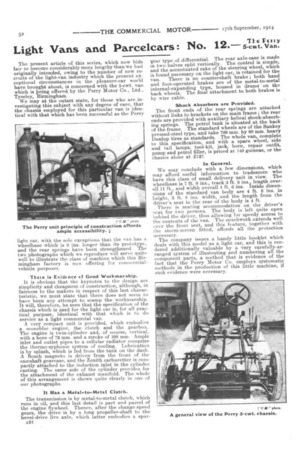Light Vans and Parcelcars : No. 1.2.- 5 . 7 ,,Le t . r x ,ainlY.
Page 18

If you've noticed an error in this article please click here to report it so we can fix it.
The present article of this series, which now bids fair to become considerably more lengthy than we had originally intended, owing to the number of new recruits of the light-van industry which the present exceptional circumstances in the pleasure-car world have brought about, is concerned with the 5-cwt. van which is being offered by the Perry Motor Co., Ltd., Tyseley, Birmingham.
We may at the outset state, for those who are investigating this subject with any degree of care, that the chassis employed for this particular van is identical with that which has been successful as the Perry light car, with the sole exceptions that the van has a wheelbase which is 9 ins, longer than its prototype, and the rear springs have been strengthened. The two photographs which we reproduce will serve quite well to illustrate the class of machine which this Birmingham factory is now offering for commercialvehicle purposes.
There is Evidrnce of Good Workmanship.
It is obvious that the keynotes to the design are simplicity and cheapness of construction, although, in fairness to the makers in respect of this last characteristic, we must state that there does not seem to have been any attempt to scamp the workmanship. It will, therefore, be seen that the specification of the chassis which is used for the light car is, for all practical purpose, identical with that which is to do service as a light commercial van. A very compact unit is provided, which embodies a monobloe engine, the clutch and the gearbox. The engine is twin-cylinder and, of course, vertical, with a bore of 72 mm. and a stroke of 108 ram. Ample inlet and outlet pipes to a cellular radiator comprise the thermo-syphonic system of cooling. Lubrication is by splash, which is fed from the tank on the dash. A Bosch magneto is driven from the front of the camshaft gearcase, and the Zenith carburetter is compactly attached to the induction inlet in the cylinder casting. The same side of the cylinder provides for the attachment of the exhaust manifold. The whole of this arrangement is shown quite clearly in one of our photographs. sear type of differential. The rear axle-case is, made in two halves split vertically. The control is simple, and the accentuated rake of the steering wheel, which is found necessary on the light car, is retained for the van. There is no countershaft brake ; both hand and foot-operated brakes are of the metal-to-metal internal-expanding type, housed in drums on the back wheels. The final attachment to both brakes is by wire cable.
Shock Absorbers are Provided.
The front ends of the rear springs are attached without links to brackets on the main frame ; the rear ends are provided with auxiliary helical shock-absorbing springs. The petrol tank is situated at the back of the frame. The standard wheels are of the Sankey pressed-steel type, and take 700 mm. by 80 mm. heavy Dunlop tires as standards. The whole van, complete to this specification, and with a spare wheel, side and tail lamps, tool-kit, jack, horn, repair outfit, pump and petrol filler, is priced at 140 guineas, or the chassis alone at 2127.
In General.
We may conclude with a few dimensions, which may afford useful information to tradesmen who have this class of small delivery unit in view. The wheelbase is 7 ft. 9 ins., track 3 ft. 8 ins., length overall 11 ft., and width overall 4 ft. 6 ins. Inside dimen-sions of the standard van body are 4 ft. 6 ins. in height, 3 ft. 8 ins, width, and the length from the driver's seat to the rear of the body is 4 ft.
There is seating accommodation on the driver's seat for two persons. The body is left quite open behind the driver, thus allowing for speedy access to the contents of the van. The coachwork extends well over the front seat, and this feature, together with the storm-screen fitted, affords all the protection necessary.
The company issues a handy little beoklet which deals with this model as a light car, and this is rendered additionally valuable by a very carefully-arranged system of illustrating and numbering all the component parts, a method that is evidence of the fact that. the Perry Motor Co. employs systematic methods in the production of this little machine, if such evidence were necessary.






















